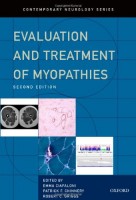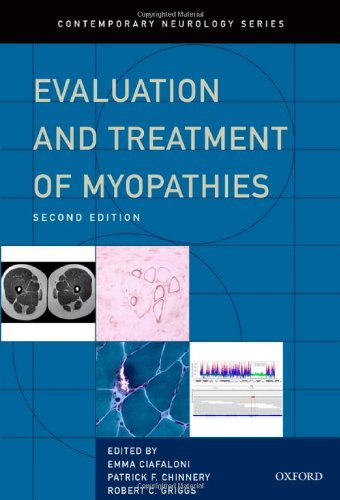 Editors: Emma Ciafaloni, MD; Patrick F. Chinnery, FRCP; and Robert C. Griggs, MD
Editors: Emma Ciafaloni, MD; Patrick F. Chinnery, FRCP; and Robert C. Griggs, MD
Contemporary Neurology Series Editor: Sid Gilman, MD
Publisher: Oxford University Press – 364 pages
Book Review by: Bina Odhar
This is a book for trainees and physicians treating patients with neuromuscular diseases such as the various types of myopathy itemized in the contents below. Its basic purpose is to arm the clinician with specific information necessary to make a diagnosis and design a treatment plan. Much of that information has been gathered in the last 20 years or so since the first edition of this book was published in 1995.
So this second edition virtually replaces the previous one, with new information written by some of the top neurologists in the world who are specialists in their specific areas of practice and research.
What is covered in this book? Below is its table of contents that gives you an overview.
- Approach to the Patient with Muscle Disease
- Structure and Function of Normal Muscle
- Evaluation of the Patient with Myopathy
- Genetic Evaluation of the Patient and Family
- Specific Myopathies
- The Muscular Dystrophies
- Myofibrillar Myopathies
- Congenital Myopathies
- Metabolic Myopathies
- Mitochondrial Myopathy
- Muscle Channelopathies
- Inflammatory Myopathies
- Myopathies of Systemic Disease and Toxic Myopathies
- General Strategies of Clinical Management
- Muscle Pain and Fatigue
- Prevention and Management of Systemic Complications of Myopathies
Among other uses, this book provides:
- Advice on how to elicit information from the patient and family
- Data and assessment methods of patients with symptoms of muscle disease
- Guidance on the next steps in diagnosis
- Latest information on pathogenesis
- Perspective on how to evaluate and care for patients
- Treatment options in specific cases
The chapters list topics at the beginning, provide an Introduction and sometimes a Definition of the disease or disorder covered in it.
For example, chapter 2 entitled Evaluation of the Patient with Myopathy provides an Introduction of several paragraphs; a Definition of, and main types of myopathy; and headings of topics discussed in the chapter entitled: Clinical Evaluation, Differential Diagnosis, Laboratory Evaluation, Electrodiagnosis, Muscle Biopsy, and Nerve Biopsy. A list of References for further study is provided at the end of the chapter.
One of the techniques the editors use is to present bullet-point information in boxes. In this second chapter for example, Box 2.1 entitled Definition of Myopathy: Clinical Criteria lists the following as Clinical Features Suggestive of Myopathy:
- Distribution of Weakness: proximal, symmetric
- Muscle bulk: relatively preserved or enlarged
- Muscle palpitation (unreliable: indurated, tender)
- Muscle percussion: diminished muscle contraction; myotonia, rippling
- Reflexes: parallel muscle strength
In that box are also listed Clinical Features Contravening Myopathy:
- Distal weakness
- Fasciculations: suggest anterior horn cell disease
- Tongue atrophy
- Tremor: suggests peripheral neuropathy, anterior horn cell disease, or CNS disease
- Sensory signs (or symptoms): suggest peripheral neuropathy or CNS disease
- Pathologic fatigue: suggests neuromuscular junction defect
- Early absence of reflexes
Charts, figures, micrographs, photos, scans, and tables are used throughout the book to aid in learning.
This is a definitive and authoritative text on evaluating and treating myopathies and related neuromuscular diseases and disorders.
Michael Brooke, who wrote the Foreword to this book, says of the people listed below: “To say that they are eminent in their field is to understate the case. They have the quality that I mentioned above of bridging the gap between old and new. More than that they have the perspective to be able to tell us, not only what is true and important today but what is likely to remain true in the decade.”
The editors and authors listed below deserve extraordinary recognition for their efforts in putting this valuable and unique book together.
Authors and Editors:
Emma Ciafaloni, MD is Associate Professor of Neurology and Pediatrics in the Department of Neurology at University of Rochester School of Medicine and Dentistry in Rochester, New York.
Patrick F. Chinnery, FRCP, FMedSci is Director of the Institute of Genetic Medicine at Newcastle University in Newcastle upon Tyne, United Kingdom.
Robert C. Briggs, MD is Professor of Neurology, Medicine, Pediatrics, Pathology, and Laboratory Medicine in the Center for Human Experimental Therapeutics in the Department of Neurology at the University of Rochester School of Medicine in Rochester, New York.
Sid Gilman, MD, FRCP is the William J. Herdman Distinguished University Professor of Neurology at the University of Michigan.
Contributing Authors:
Anthony A. Amato, MD – Harvard Medical School, Boston, Massachusetts
Patrick Gordon, FRCP, PhD, MBBS – King’s College Hospital, London, UK
Graine S. Gorman, MRCP – Institute for Ageing and Health, Newcastle University, UK
Michael K. Hehir, MD – University of Vermont, Burlington, Vermont
Heinz Jungbluth, MD, PhD, MRCP, MRCPCH – King’s College, London, UK
Wendy M. King, PT – Wexner Medical Center, Ohio State University, Columbus, Ohio
Andrew Mammen, MD, PhD – Johns Hopkins University School of Medicine, Baltimore, MD
Francesco Muntoni, FRCOCH, FMedSci – UCL Institute of Child Health, London, UK
Gerald Pfeffer, MD, CM, FRCPC – Institute of Genetic Medicine, Newcastle upon Tyne, UK
Araya Puwanant, MD – University of Rochester School of Medicine, Rochester, New York







